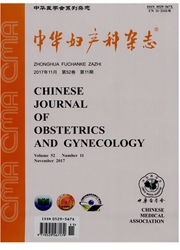

 中文摘要:
中文摘要:
目的在全基因组DNA水平探讨孤雄完全性葡萄胎患者的相关基因,并探索其发生的分子机制。方法短串联重复序列(STR)基因位点鉴定孤雄完全性葡萄胎的亲代来源;人基因组U133 Plus2.0寡核苷酸芯片检测孤雄完全性葡萄胎和正常早孕绒毛组织中全基因组DNA水平的差异表达基因,荧光定量RT-PCR技术验证小部分差异表达基因;对寡核苷酸芯片检测的数据进行生物信息学分析。结果11例经病理检查确诊的完全性葡萄胎患者中,其基因组DNA经STR基因位点鉴定显示,9例(82%)为父系来源,2例(18%)为双亲来源;寡核苷酸芯片检测显示,和正常早孕绒毛组织相比,孤雄完全性葡萄胎组织中表达上调基因279个,占检测基因的0.72%(279/38500),表达下调基因1710个,占检测基因的4.44%(1710/38500);小部分差异表达基因的荧光定量RT-PCR技术检测与寡核苷酸芯片检测结果一致;生物信息学分析显示,差异表达基因涉及多个生物学过程和通路,其中印迹基因的变化和生长激素及人胎盘生长催乳激素基因的变化尤为明显。结论孤雄完全性葡萄胎的发生、发展是涉及多基因、多途径的复杂过程,其中印迹基因和生长激素类基因表达改变起蕈要作用。
 英文摘要:
英文摘要:
Objective To compare genomic expression differences between androgenic complete hydatidiform mole (AnCHM) and normal first trimester villi with similar gestation weeks, and search for potential adjuvant diagnostic molecular markers. Methods Short tandem repeat (STR) detection was used to identify AnCHM, human oligonucleotide array U133 Plus :2. 0 was used to measure genomic expression differences between AnCHM and normal villi, and quantitative fluorescent RT-PCR was used to verify array of several genes. Results Nine of 11 histologically diagnosed complete hydatidiform moles were found to be AnCHM by means of STR, and the other :2 were biparental complete hydatidiform mole (BiCHM). Compared with villi, oligonucleotide array showed :279 genes (0. 72% , :279/38 500) were over expressed and 1710 genes (4.44%, 1710/38 500) under expressed in AnCHM. Bioinformatics analysis found that differentially expressed genes were involved in multiple biological processes and pathways. Changes of imprinting genes, growth hormone genes and chorionic somatomammotropin hormone genes were especially remarkable. Conclusions Pathogenesis of AnCHM is a complex process involving multiple genes and pathways. Altered expression of imprint genes may play important roles in the process.
 同期刊论文项目
同期刊论文项目
 同项目期刊论文
同项目期刊论文
 期刊信息
期刊信息
